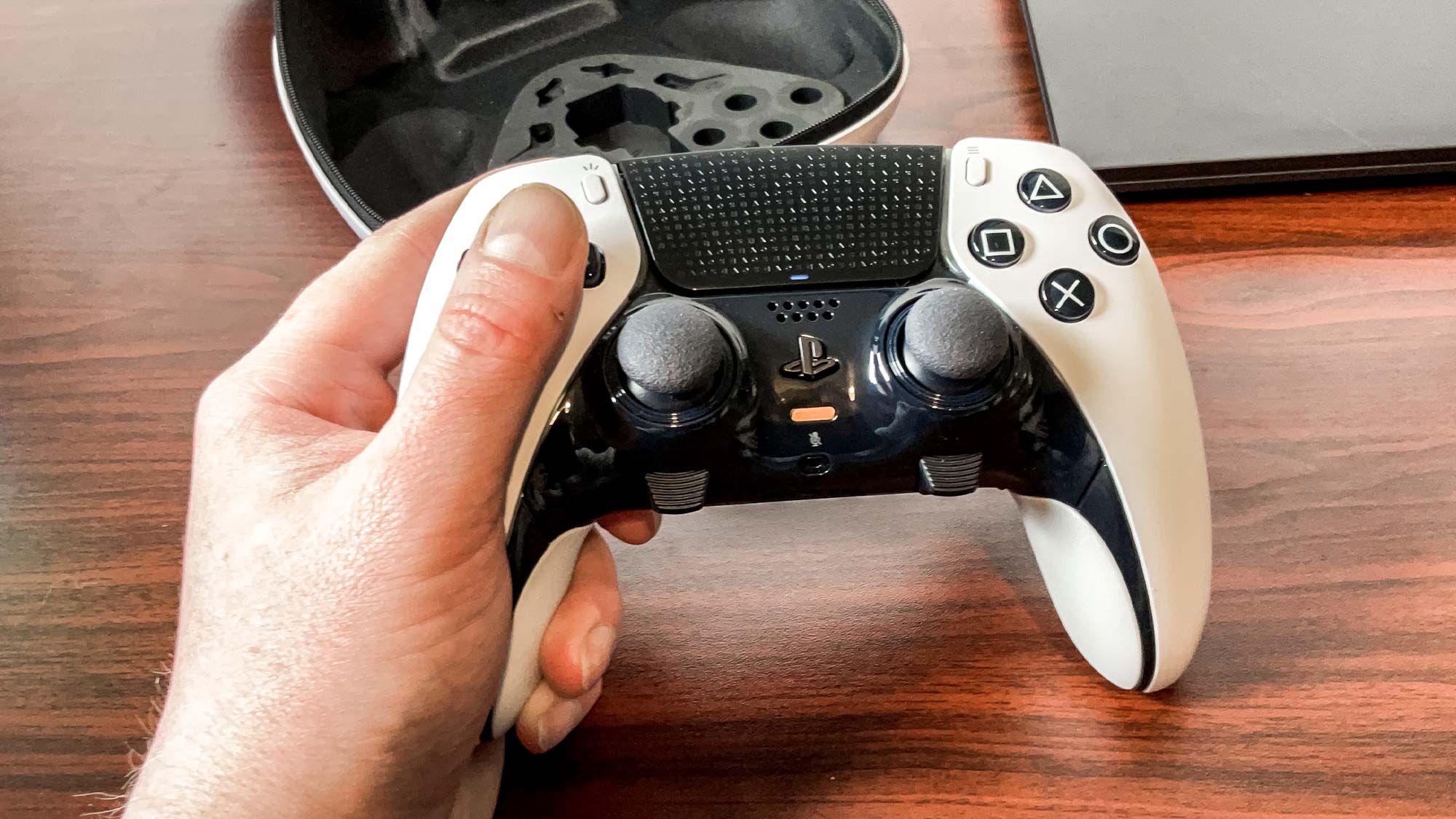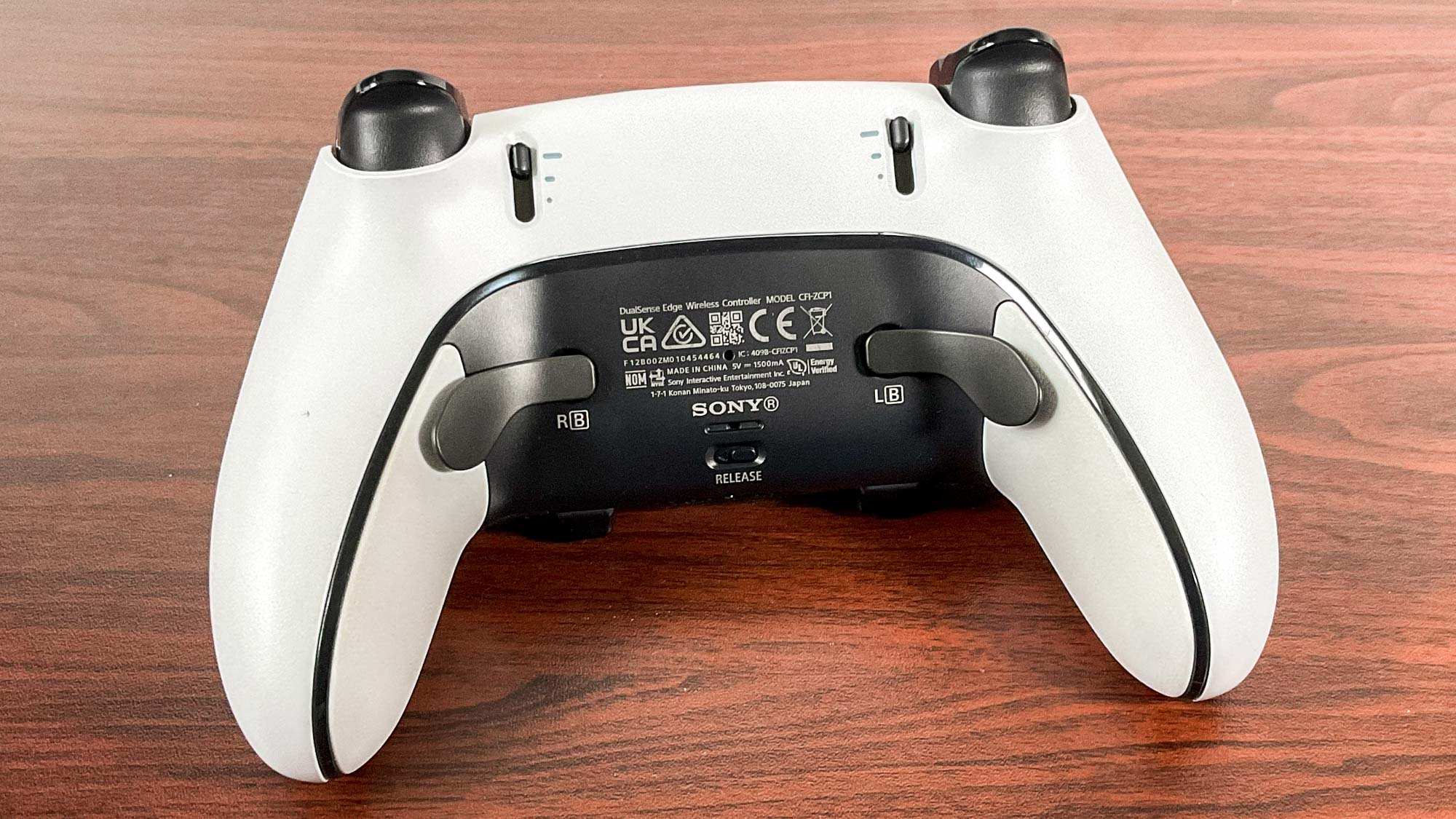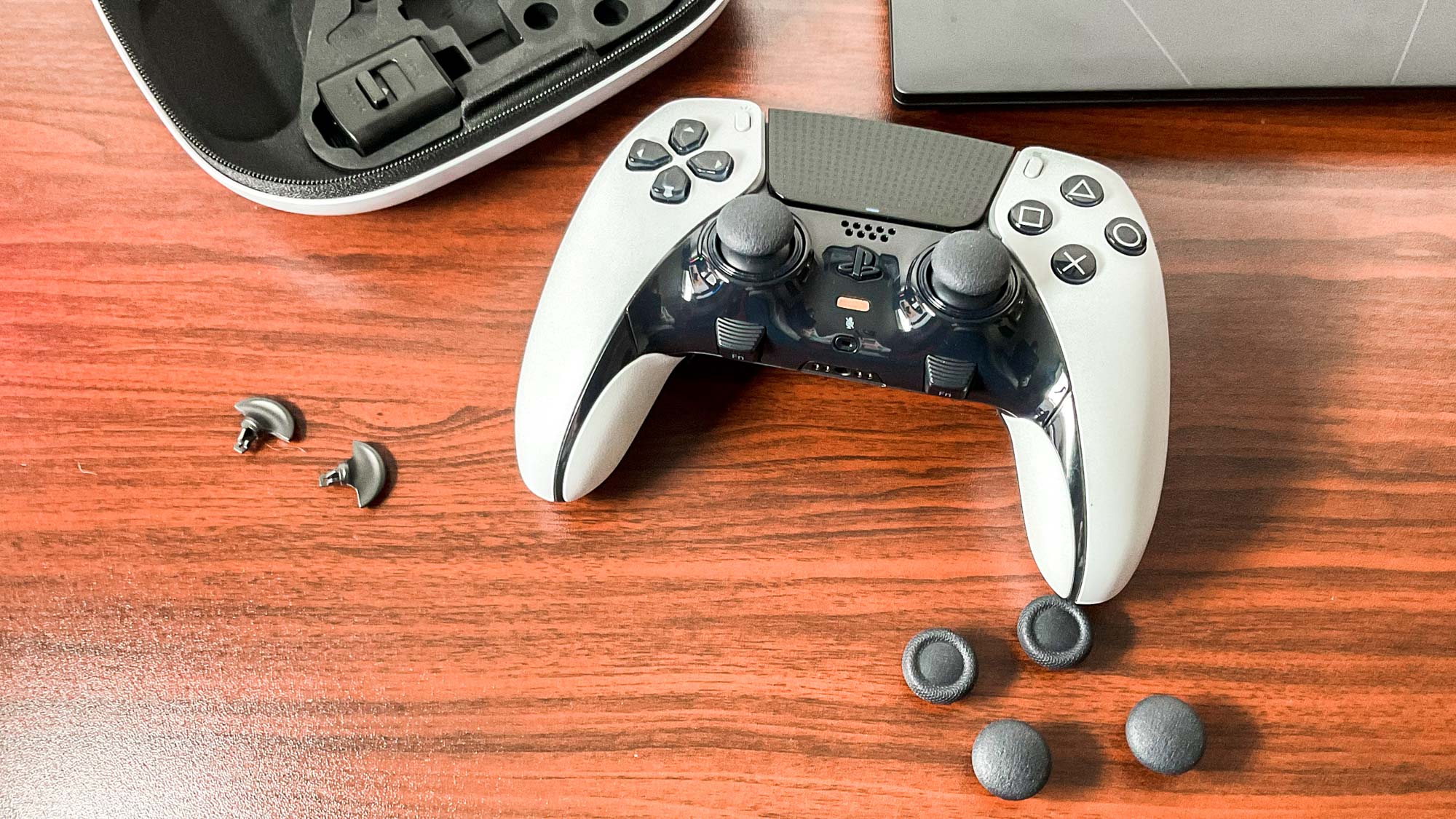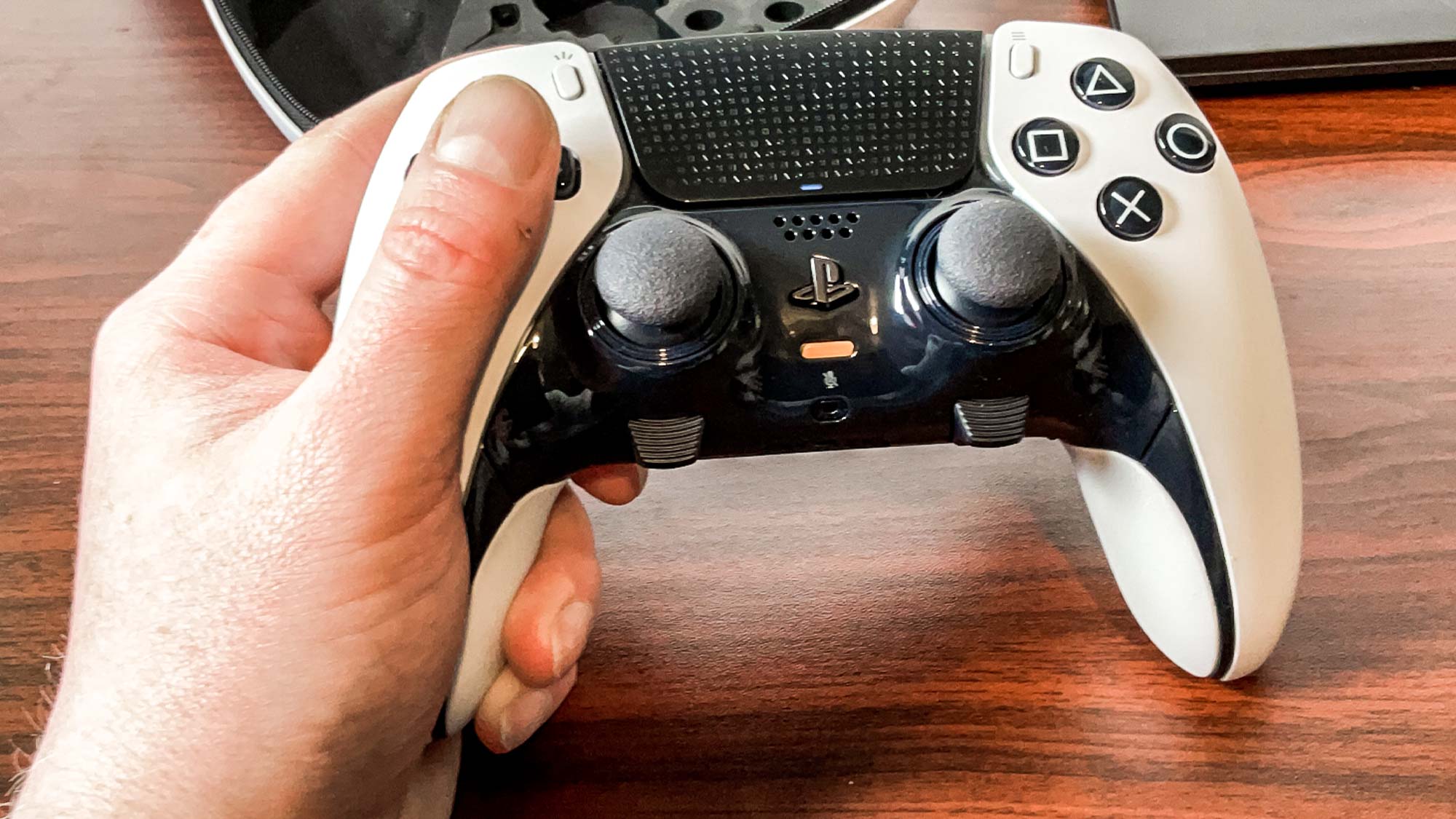Tom's Guide Verdict
The DualSense Edge is a fantastic, highly customizable controller that should be easier to recommend than it actually is. If it was $50 cheaper and battery life was a little better, the DualSense Edge would be the best gamepad Sony has ever made. Unfortunately, the performance-to-price ratio is skewed.
Pros
- +
Higher-end version of the excellent DualSense
- +
Metallic back buttons are a game-changer
- +
Sony's customizable software is awesome
- +
Works surprisingly well as a PC controller
Cons
- -
Too expensive
- -
Battery performance simply isn't good enough
- -
Grips can discolor quickly
Why you can trust Tom's Guide
As Sony’s first official premium PS5 controller and a direct rival to Microsoft’s excellent Xbox Elite Wireless Controller Series 2, the DualSense Edge has hefty boots to fill. At $200, not only is it more expensive than the $180 Elite Series 2, it costs nearly four times what the regular $60 DualSense retails for — and that’s already one of the best PC game controllers ever made.
Can such an expensive gamepad really justify its sky-high $200 / £210 price tag? The answer is… kind of.
With brilliant rear paddles, intuitive customization options that let you remap every button, swappable thumbsticks and premium-feeling performance grips, this is a gaming accessory that gives you far more options than the regular PS5 DualSense controller.
As much as I adore the DualSense Edge’s premium finish, and the fact it builds on those brilliant fundamentals established by the default DualSense, that $200 / £210 RRP is a hard sell. This is a pad I love so much I’ve bought two of them, but for entirely the wrong reasons. Read on to find out why.
DualSense Edge review: Design

If you’ve held the regular DualSense for even a few minutes, the design, feel and weight of the Edge will be instantly familiar; though there are subtle differences. You get the same adaptive triggers, haptic feedback and gyrometer features of the normal PS5 pad wrapped up in a classier package.
Everything about the DualSense Edge feels more premium. Weighing in at 11.7 ounces, Sony’s high-end PS5 gamepad is around 15% heavier than the normal DualSense. This added heft is welcome, and makes the Edge's presence feel assured and steady, without being overly weighty.
The headline update really is those back paddles, though. I’m absolutely obsessed with them.
Get instant access to breaking news, the hottest reviews, great deals and helpful tips.
The Edge comes bundled with two pairs of these optional back buttons — one set shaped like stubby crescent moons, the other more like conventional levers. Both sets of paddles boast a classy metallic quality, and though I’ve swapped between both regularly, I normally fall back on the lever-style triggers that most closely resemble the back buttons on the Xbox Elite Series 2.

I’d say it’s a shame the DualSense Edge is limited to two back buttons when Microsoft’s high-end gamepad is treated to four. But honestly, I’ve always felt using two sets of triggers on the Elite Series 2 to be somewhat awkward, so I’m perfectly happy with the Edge’s more minimalist configuration.
The fact you can swap out the Edge's stick modules is also worth highlighting. I'm incredibly lucky in that I've never owned a controller that suffered from stick drift, but I realize I'm probably in the (fortunate) minority on that front.
That Sony gives you the option to swap out faulty sticks for replacements modules — which cost $20 / £20 — is a canny move that ensures a problem analog stick is no longer a controller-ruining issue. The swapping process is pleasingly simple, too. Thanks to a slider on the rear of the Edge, you can simply pop the sticks out without the need of a screwdriver.
There are other improvements, too. The DualSense Edge gets its own clam-shaped case to house not only this premium gamepad but its accessories — four additional thumbsticks and a 9-foot charging cable. I’ve rarely used the optional sticks, though I expect owners of both next-gen consoles will appreciate at least one pair of the Edge’s analog inputs resemble the thumbsticks of the Xbox Elite Series 2.
There are also subtle quality of life improvements to the Edge’s touchpad and triggers. L2 and R2 now boast three separate stop sliders to reduce travel distance, which is a feature that should come in handy for hardcore first-person shooter players. Said triggers and a sturdier feeling touchpad are also adorned with tiny PlayStation shape symbols that provide a slightly more tactile feeling of touch and grip than the normal DualSense.
DualSense Edge review: Customization

The Elite Series 2 and its Xbox Accessories app have thrown down the gauntlet when it comes to highly bespoke first-party controller customization. So credit to the designers at Sony for matching Xbox’s brilliant gamepad blow for blow in this area.
When it comes to customization options, the DualSense Edge goes above and beyond. Thanks to the Function keys that sit neatly below both analog sticks, you can assign up to four onboard custom button profiles at any time — one more than the Elite Series 2.
Currently, I have bespoke profiles mapped out for the brilliant Resident Evil 4 remake, Returnal, Cyberpunk 2077 and the timeless Shadow of the Colossus redux. Switching between stored profiles is as simple as holding a Fn key and clicking one of the iconic Triangle, Circle, X and Square buttons.
In a further welcome touch, you can set as many unassigned profiles as you wish, which is handy for obsessives like me who like to lean on multiple on-the-fly custom button layouts.
You can also tweak the DualSense Edge’s vibration and trigger sensitivity, while a streamlined settings menu lets you twiddle with trigger deadzones and the brightness of controller indicators. All of these additions live under their own ‘DualSense Edge Wireless Controller’ menu, which can be found under Settings > Accessories. Sony has even included an optional welcome tour mode to guide you through the Edge’s unique features.
The DualSense Edge is a highly customizable pad that I’ve taken great pleasure in fiddling with to the max. Sometimes I want to access my Cyberpunk 2077 profile — where I’ve assigned the main conversation button to the rear right paddle. At other times, I’ll instantly switch to the Returnal profile where I can slice down alien beasties with the left back button.
Regardless, the DualSense Edge’s intuitive customization options make tweaking profiles a breeze.
DualSense Edge review: Gaming performance

The highest compliment I can pay the DualSense Edge is that I’ve owned it for close to two months; during that time, I’ve rarely wanted to switch back to my three regular DualSense gamepads.
I love, love, loooooove those back buttons. So much so, I’ve barely touched the default X button since owning the Edge. My go-to custom profile on the DualSense Edge? Immediately mapping X to the rear left paddle. There’s something about the ‘clickiness’ of those metallic inputs I just can’t resist.
The DualSense Edge is also one of the best PC controllers. Thanks to recent Steam updates, you can assign commands to its rear paddles and even use the Function keys as extra "special" buttons. Right now, I’m currently using the Edge’s right Fn button to take screenshots when using Steam. Talk about handy!
There’s a colossal BUT when it comes to performance, though. And when I say colossal, imagine a problem as lofty as of one of the apartment block-sized Tallnecks Aloy regularly scales in Horizon Forbidden West.
The battery life of the DualSense Edge sucks.

After over a month of heavy usage, I find that the Edge is usually out of juice after as little of 5 hours of gameplay. Somehow, this is even worse than the 6 or 7 hours you may squeeze out of the regular DualSense — and that’s a controller which costs a fraction of the Edge. If you think that’s unacceptable, consider the fact Microsoft’s Series X’s Elite Series 2 can happily go up to 40 hours between charges.
There’s no doubt the DualSense Edge is a terrifically well-made controller, but its battery life lets it down big time. In fact, it’s so bad, I’ve ended up buying two Edges just so I can keep at least one in regular rotation while I charge its substitute.
When you have to buy the most expensive PlayStation gamepad ever made twice, something has gone wrong at the R&D level.
And I’ve got one more annoying gripe left in my system. Those premium molded plastic grips feel lovely to the touch, but hoo-boy do they deteriorate quickly. After owning a pair of DualSense Edges for a month or so, I can confirm the grips on both are now a sadly tainted yellow. Perhaps my exceptionally sweaty palms are to blame, but it feels like both a design defect — and the number one reason to release a black DualSense Edge ASAP.
DualSense Edge review: Verdict

The DualSense Edge offers easy to appreciate upgrades over the regular DualSense. When you consider the default first-party PS5 gamepad is already one of the greatest controllers ever made, that’s hardly small potatoes.
And yet I remain conflicted . I love this controller so much, I’ve bought two of them, despite some shortcomings. I'm such a sucker for playing my favorite games with PlayStation buttons and triggers across both PS5 and my GeForce RTX 4090-powered PC that I can almost overlook those battery issues.
Almost.
If your gaming history lies with PlayStation and you want to experience the best PS5 games in never-better fashion or play one of the increasingly strong ports of the likes of Marvel’s Spider-Man on PC, the DualSense Edge is an excellent option.
Just be wary that you’re going to have to charge it… a lot.
More from Tom's Guide
- PS5 DualSense is one of the coolest controllers ever made
- Xbox Elite Wireless Controller Series 2 Review: The Best Gets Better
- The best PS5 games in 2023

Dave is a computing editor at Tom’s Guide and covers everything from cutting edge laptops to ultrawide monitors. When he’s not worrying about dead pixels, Dave enjoys regularly rebuilding his PC for absolutely no reason at all. In a previous life, he worked as a video game journalist for 15 years, with bylines across GamesRadar+, PC Gamer and TechRadar. Despite owning a graphics card that costs roughly the same as your average used car, he still enjoys gaming on the go and is regularly glued to his Switch. Away from tech, most of Dave’s time is taken up by walking his husky, buying new TVs at an embarrassing rate and obsessing over his beloved Arsenal.

